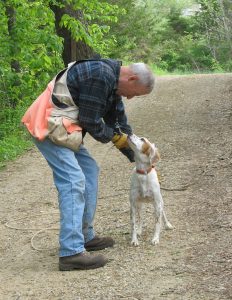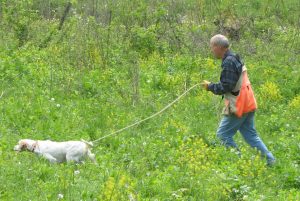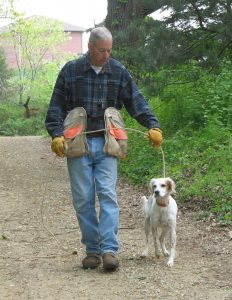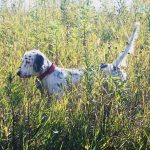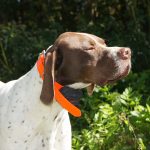Back to Basics: Control and Handling
POINTING DOG POINTERS
By Bob and Jody Iler
That young pup that followed you everywhere is growing up! You’ve taken her through a puppy program, basic yard work, and developed her as a started pointing dog. But like all youngsters that morph into the “teenage” phase of life, you may have noticed some changes in your young dog during or after her first season in the field, or maybe even sooner.
The pup that once handled well, turning to the whistle and coming back to you when called, may now seem to have suddenly gone deaf. Or he may handle well for awhile and suddenly bolt off out of sight, paying no attention to your call or whistle. Some young pups, independent by nature anyway, start to assert this independence more by showing lack of control—not quartering well, maybe self-hunting, and not responding to commands from you.
We like independence and boldness in young dogs; these are the traits of great bird dogs. The trick is to find that fine, invisible line—the line between letting him have his head and teaching him to work as your partner. With young dogs, we especially do not want to dampen that boldness, spirit and enthusiasm, but we do need to “harness” it before it gets out of hand.
A lot depends, too, on genetics. Some pointing dogs come from long lines of big-running dogs. Some come from more of a “foot-dog” background. But whether she scours the countryside or works a comfortable distance from you, your dog should always be aware of you and responsive to you. How well she does this does depend on her age. Young dogs are bound to make mistakes. With your guidance and patience, they learn over time. As your dog matures and becomes a seasoned, well-trained hunting partner, lack of control should become a non-issue if you take the steps now to remind your dog, whenever necessary, what you want from him.
Important to remember in the issue of control is the phrase “too many.” Too many birds, too many dogs in the field, too many whistles and calls made in attempts to handle the dog—these things will overwhelm the young, inexperienced dog, teaching him inappropriate responses.
Lots of birds are mind-boggling to the young dog and will cause him to range too far out, bust birds and ignore your commands. Other dogs in the field will distract and even detrain your dog; if they have no control, they will encourage your dog to act the same. And repeated commands and whistles without any reinforcement simply teach your dog that directions can be ignored!
If your young dog is showing signs of lack of control, it’s time to go back to the basics. When you started your training, you used a shorter line or lead for heeling and whoa work. When you taught the here (come) command, you switched to a longer line, or checkcord. As you introduced your dog to quartering and handling in the field, you used a 15-20 oot checkcord. These simple tools were ways to show your dog what you wanted and to enforce your commands as he learned.
And now that he’s testing you, it’s time to get those basic tools out and go back to the beginning stages of training again. Start having regular, short yard work sessions every day or at least several times a week. Yard work teaches one-to-one bonding, eye contact, and the teamwork so important in working as hunting partners. These sessions will remind your dog that you are in charge and will provide the opportunity for praise, encouragement and reinforcement of early lessons.
Next, the checkcord provides the tool that emphasizes the here command. When you call your dog to come to you, you’re not asking him! You must always be able to enforce this command when given and you can’t enforce it without the checkcord.
Sincere positive praise will do wonders for reinforcing this command as well. Don’t be the trainer who teaches and commands his dog and forgets to let pup know what a good job he’s doing! Dogs thrive on firm control followed by praise. They really do want to please us, but we need to be the “leader,” or just like kids, they’ll take advantage.
Going back to the basics in the field requires the checkcord as well. Leave birds out of the equation as you work to reinstill and remind your dog about quartering. Zig-zag in a forward pattern and pop the checkcord as you change directions. Initially we use a whistle as we pop the checkcord; as the dog learns to quarter, we often stop using the whistle to help pup learn to pay attention to where we are going, using only the reminder of the checkcord pop when needed. If you have regular quartering sessions with your dog, he’ll soon be back in the groove and begin to handle as he did before he started showing signs of “deafness.”
Don’t remove the checkcord yet though! We let the dog drag the checkcord for quite awhile after he’s had reinforcement lessons. If he continues to do well, we remove the checkcord and let him drag a shortened line. The idea is that we want him to know that there is a control mechanism attached to him and to us, the “leaders.” As a dog matures and learns to handle with reliability, it’s all right to return to using your whistle when needed. The point here is that the more yelling and whistling that we do, the less effective our training is. Enforcement through action teaches control.
Quartering practice in the field is also a good time to practice the here command when your dog is not expecting it. Don’t do this often, just now and then, to teach him that even when he is hunting and quartering, if you call him, he must come to you.
Birds can be reintroduced back into the training program once your dog is handling well for you again. Keep in mind, though, that you may need that checkcord for quite awhile when birds come back into the mix, simply because of his enthusiasm for them. This is normal and to be expected.
Going back to the basics is crucial in addressing early signs of control issues and in preventing future handling problems. During this phase of retraining and reinforcement, don’t hunt your dog with other dogs and handlers. Stay away from group hunts and never loan your dog out to someone else!
If you follow our recommendations for back to basics with control work and still find that your enthusiastic, bold young dog is a tough nut to crack, it may be time to consider another reinforcement tool—the e-collar. We don’t recommend using the e-collar on young dogs that haven’t developed an intense love for birds and have not been hunted for at least one season.
Pointing Dog Pointers features monthly training tips by Bob and Jody Iler, who own Green Valley Kennels in Dubuque, Iowa. Bob and Jody have trained pointing dogs for over 35 years and have written many articles for The Pointing Dog Journal.



